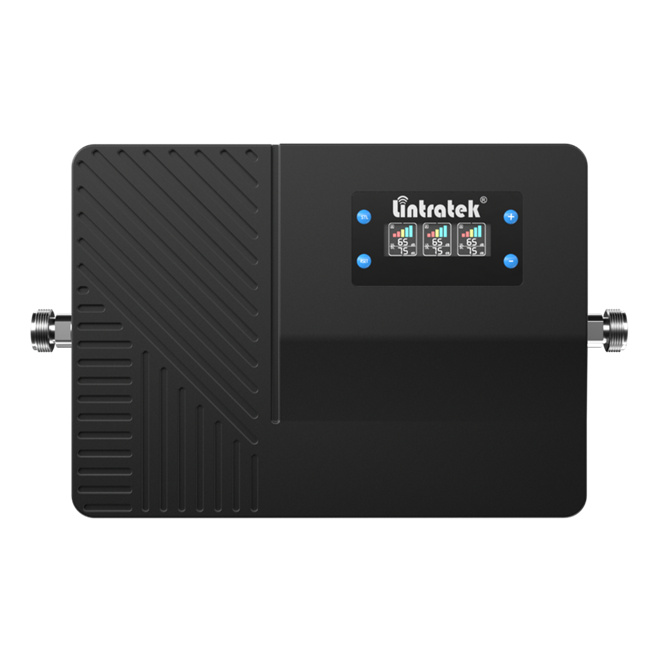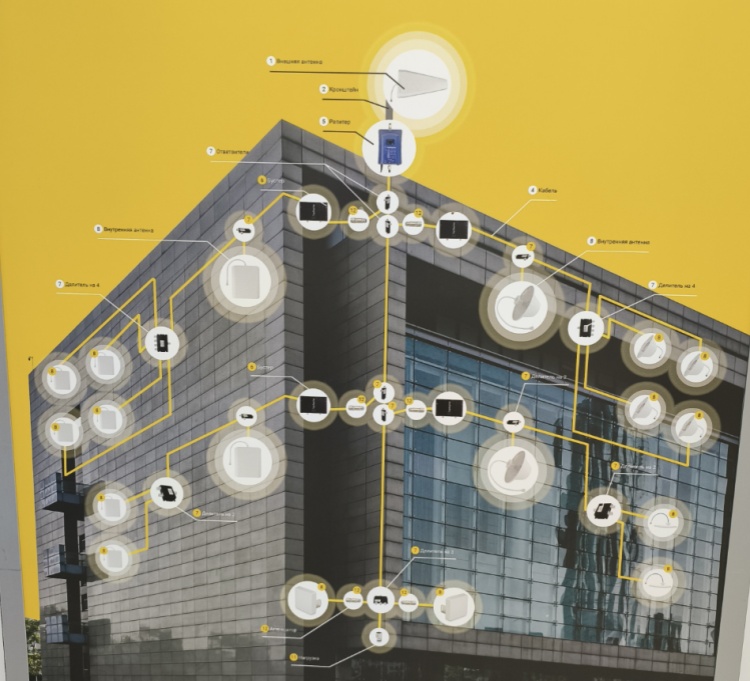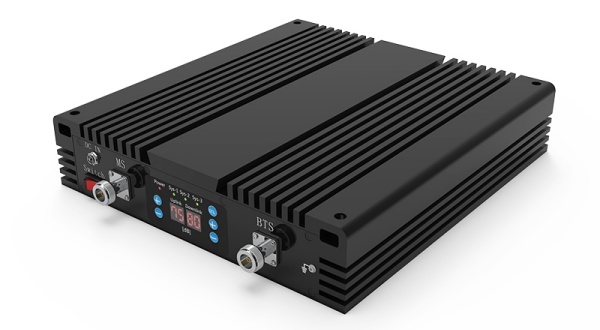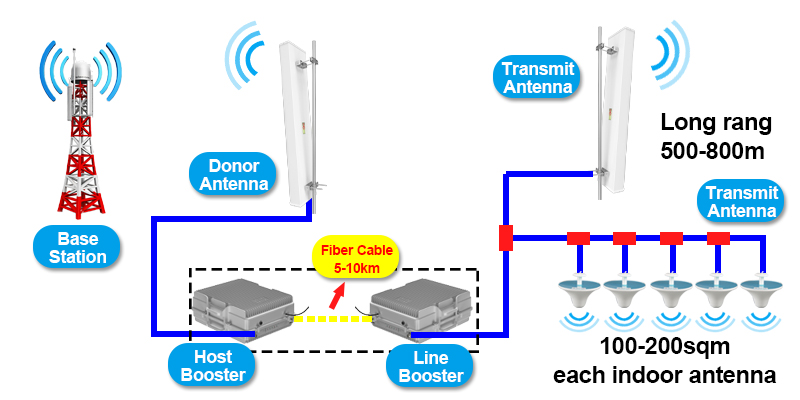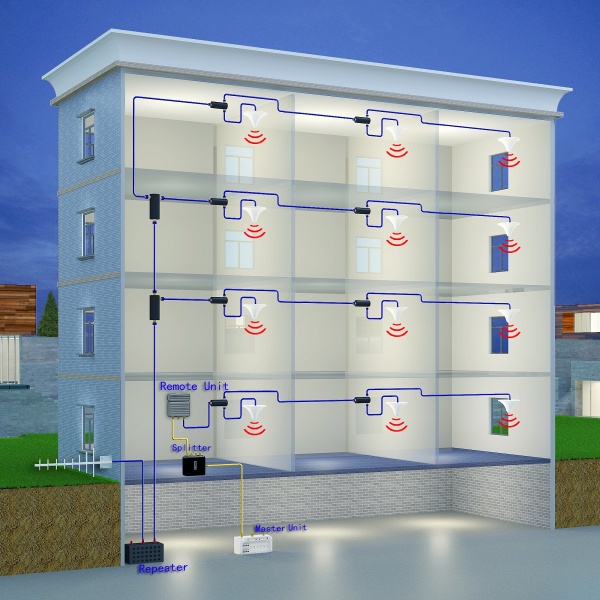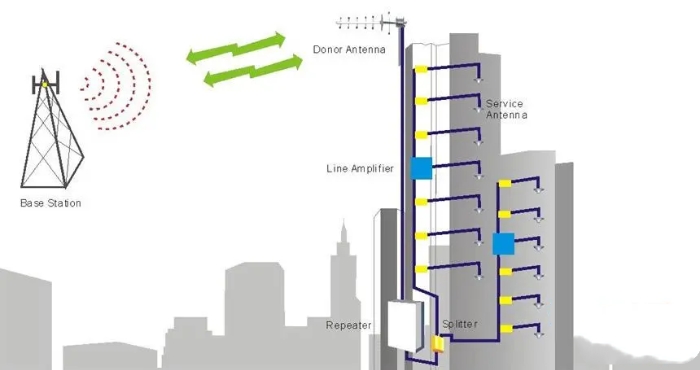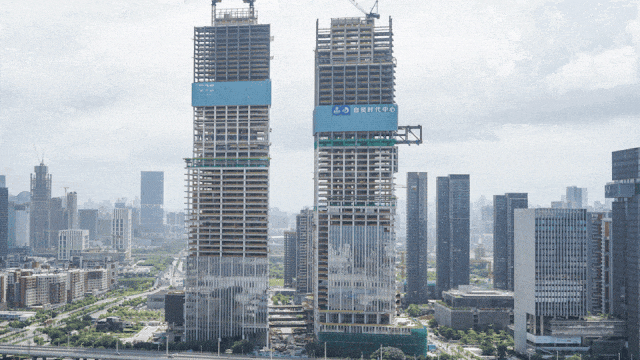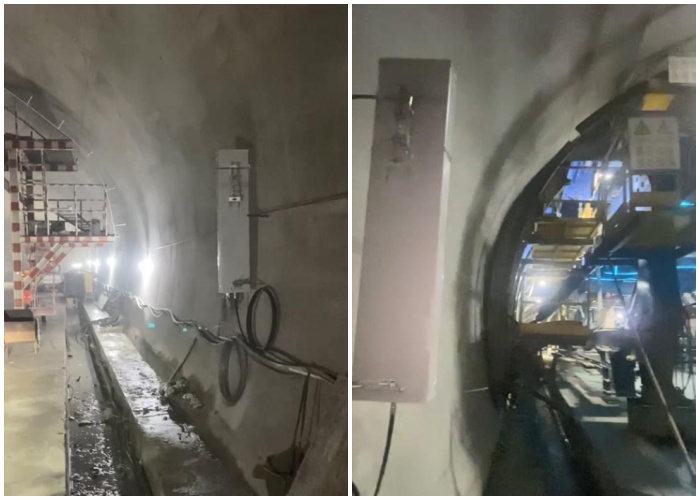When you need strong, reliable indoor coverage in a large building, a Distributed Antenna System (DAS) is almost always the solution. A DAS uses active devices to boost outdoor cellular signals and relay them indoors. The two main active components are Fiber Optic Repeaters and Commercial Mobile Signal Boosters, paired with Line Boosters. Below, we’ll explain how they differ—and which is right for your project.
1. Commercial Mobile Signal Booster with Line Booster
What it is:
For small to mid-sized buildings, you can use a Commercial Mobile Signal Booster together with a Line Booster (sometimes called a trunk repeater) to supply gain. The outdoor signal feeds into the booster, which amplifies it and sends it through coaxial cables to indoor antennas.
When to use it:
Good outdoor signal nearby. If you can pick up a strong cell signal just outside, and the distance from the outdoor antenna to the indoor splitter (the “trunk line”) is short, this setup works well.
Budget-conscious projects. Equipment costs are generally lower than fiber-based solutions.
Lintratek KW27A Commercial Mobile Signal Booster
How it works:
1.An outdoor antenna picks up the existing cell signal.
2.Commercial Mobile Signal Booster amplifies that signal.
3.Line Booster provides a second gain boost along the long feeder line if needed.
4.Indoor antennas broadcast the boosted signal throughout the building.
The DAS of Commercial Mobile Signal Booster Schematic Diagram
Advantages:
-Cost-effective for buildings under ~5,000 m² (55,000 ft²).
-Simple installation with off-the-shelf components.
Line Booster
Disadvantages:
Long-line losses. Signal still degrades over long coax runs. Even placing the booster close to the indoor or outdoor antenna can’t eliminate that entirely. You may need a higher-power commercial mobile signal booster to compensate.
-Noise stacking. If you add more than ~6 Line Boosters, each one’s noise accumulates, degrading overall signal quality.
-Input power limits. Line Boosters require an input between –8 dBm and +8 dBm; too weak or too strong and performance drops.
-More devices, more failure points. Each extra active unit raises the chance of a system fault.
-Higher-data networks. For heavy 4G/5G traffic, the noise floor on coax solutions can undermine data throughput.
2. Fiber Optic Repeater
What it is:
A Fiber Optic Repeater uses digital fiber links instead of coax. This is the go-to choice for large buildings or sites with long-distance outdoor signals.
Lintratek 4G 5G Digital Fiber Optic Repeater
Advantages:
-Low loss over distance. Fiber spans up to 8 km with negligible signal loss—far better than coax. Lintratek’s digital Fiber Optic Repeater supports up to 8 km from source to headend.
-Multi-band support. Fiber solutions can be tailored to all major cellular bands (including a wide array of 5G frequencies), whereas coax Line Boosters often cover fewer bands.
-Ideal for large complexes. Big commercial business building, campuses, or venues almost always use fiber—its consistency and low attenuation guarantee uniform coverage.
How Does Fiber Optic Repeater Work
Disadvantages:
-Higher cost. Digital Fiber Optic Repeaters are pricier upfront. However, their durability, low failure rate, and superior signal quality make them the premium choice for demanding commercial deployments.
3. Which Solution Fits Your Building?
Under 5,000 m² (55,000 ft²):
A Commercial Mobile Signal Booster + Line Booster + DAS is usually the best value.
Above 5,000 m² (55,000 ft²) with limited budget:
Consider an analog Fiber Optic Repeater paired with DAS. It offers better distance than coax at a moderate price.
Complex buildings or Long distance Transmission (tunnels, highways, rail):
A digital Fiber Optic Repeater is essential. Its low-noise, high-quality digital transport ensures uninterrupted service—even over kilometers.
Tip: In existing fiber-based DAS installations, you can “top up” coverage in smaller wings or rooms by adding a Line Booster as a supplement.
4. Market Trends
Global preference: Most countries switch to Fiber Optic Repeaters once coverage areas exceed ~5,000 m² (55,000 ft²).
Regional habits: In some Eastern European markets (e.g., Ukraine, Russia), traditional coax booster systems remain popular.
Technology shift: While 2G/3G eras saw widespread use of Commercial Boosters + Line Boosters, the data-hungry 4G/5G world is accelerating fiber adoption. Falling fiber repeater costs are driving larger deployments.
5. Conclusion
As 5G matures—and 6G looms on the horizon—digital Fiber Optic Repeaters will capture greater market share for commercial DAS deployments. Their high power, long-distance, low-noise transmission delivers the high-speed reliability that modern users demand.
Lintratek Fiber Optic Repeater Project of Complex Building
Fiber Optic Repeater in Tunnel
About Lintratek:
With 13 years of expertise in mobile signal boosters, Fiber Optic Repeaters, and antenna systems, Lintratek is your go-to manufacturer and integrator. From remote tunnels, oil fields, and mines to hotels, offices, and shopping malls, our proven projects ensure you get the best DAS solution for your needs.
Post time: May-06-2025








